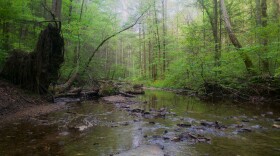A toxic algal bloom moving down the Ohio River recently prompted state officials to advise people to avoid recreational contact with the water.
Louisville’s residents are among the 3 million people who rely on the Ohio River for drinking water, but Louisville Water Co. scientists say the city’s treatment system should be able to remove the contamination.
These algal blooms are a type of cyanobacteria, or blue-green algae. The cyanobacteria produce cyanotoxins, which can irritate your skin or cause nausea and other gastrointestinal problems. Last year, a giant algal bloom in Lake Erie caused Toledo to lose drinking water for several days.
Algal blooms in this region's lakes are fairly common, thanks to nutrient runoff and warmer water. River blooms are rarer.
“It’s very unusual to see a bloom of microcystis — a species like this — in the Ohio River,” said water company scientist Roger Tucker.
Tucker’s job is to test for and analyze algae. It's a full-time job because there’s always algae in the water — but it’s not always cyanobacteria, or toxic algae.
“It’s not unusual to see a colony or two of this; it’s a natural part of the river ecosystem, it’s been there for thousands of years,” Tucker said. “And I could probably go to any lake, any stream, any river in the country, in the state, and probably find a colony or two of this. What’s unusual is that this species has grown this much.”
Tucker has been sampling upriver to get an understanding of the scope of the problem. He has also been sampling the river near where it enters the water company’s system. Then, he tells what he's found to coworkers such as Mark Campbell, another scientist with the water company.
It’s Campbell's job to determine how to treat the drinking water so it’s safe and tasty once it hits the taps.
In this instance, the contaminants include the cyanobacteria and the compounds they produce, cyanotoxins, Campbell said. The Crescent Hill treatment plant uses several barriers to remove these and other contaminants.
The first step of the process is at the reservoir. As the water pours in, it’s noticeably black from the activated carbon that’s been added to it. The carbon absorbs and removes the cyanotoxins.
Next, when the water moves to the basins across the street, the water company adds coagulants. These cause the algae to clump together, so employees can physically remove them from the water.
The final step is inside the water filtration plant. In the long, cavernous filter gallery, chlorine is added to the water and the final product is filtered.
In one more room in the laboratory, water runs out of seven labeled taps. It’s here where Campbell and his colleagues can test the water through each stage of the process — from the river to consumer taps — and see whether the treatment is working.
For now, the water company’s tests show that all of the cyanobacteria and cyanotoxins are broken down and removed from the company’s finished product, and Campbell doesn’t see any problem continuing to remove the algae as the bloom moves closer to Louisville.





